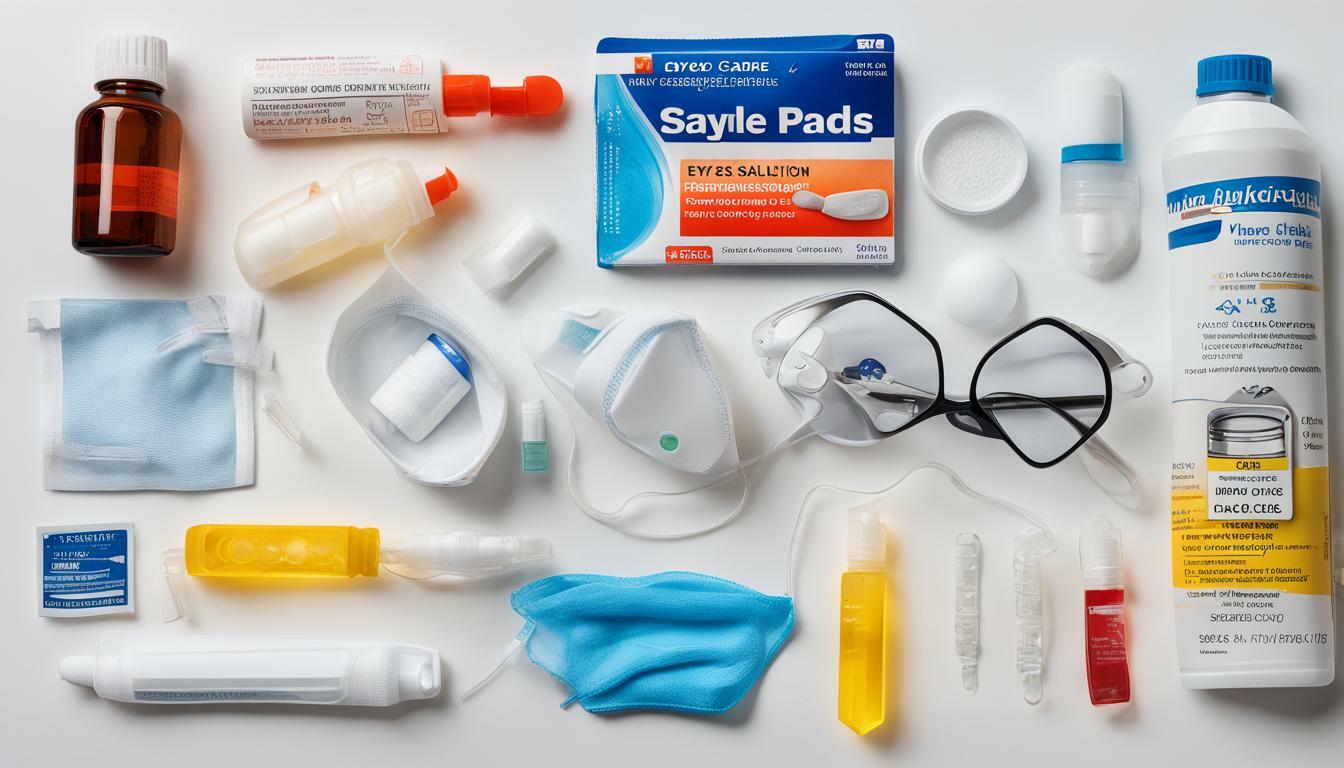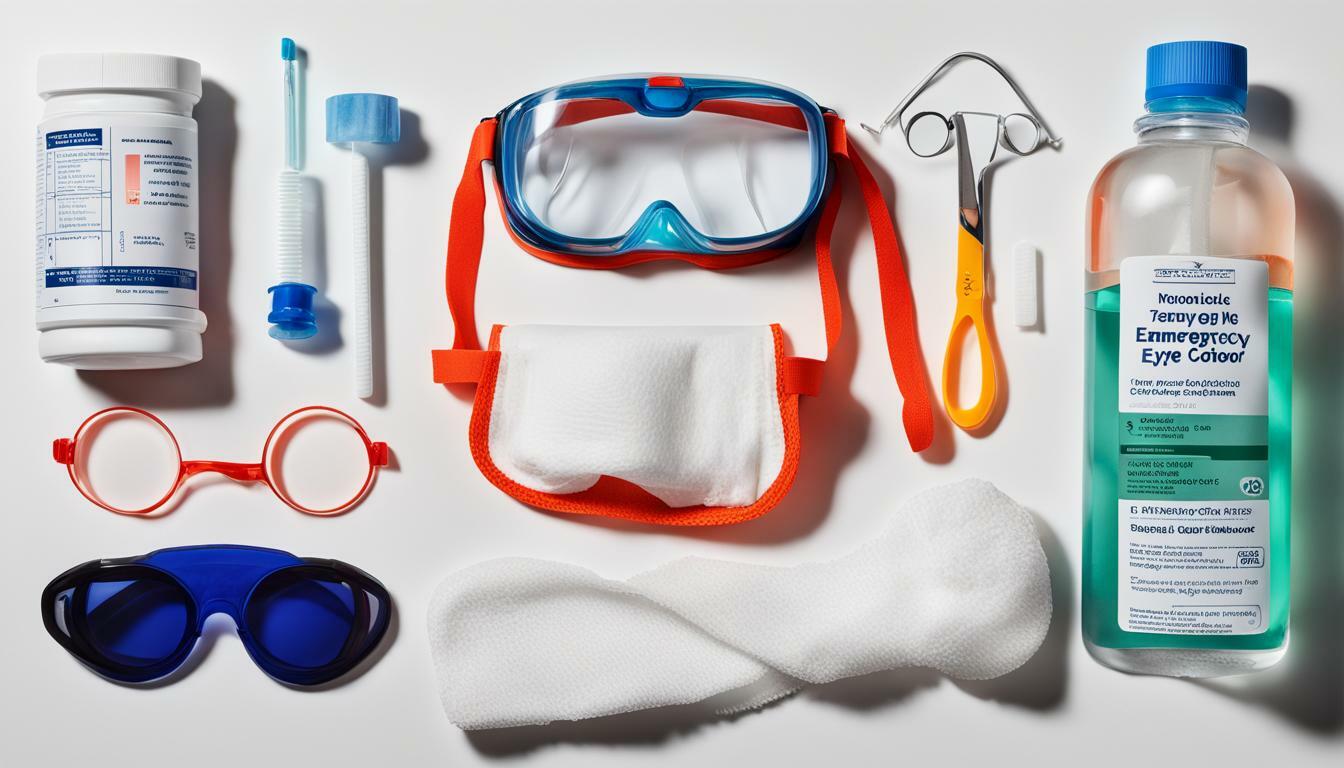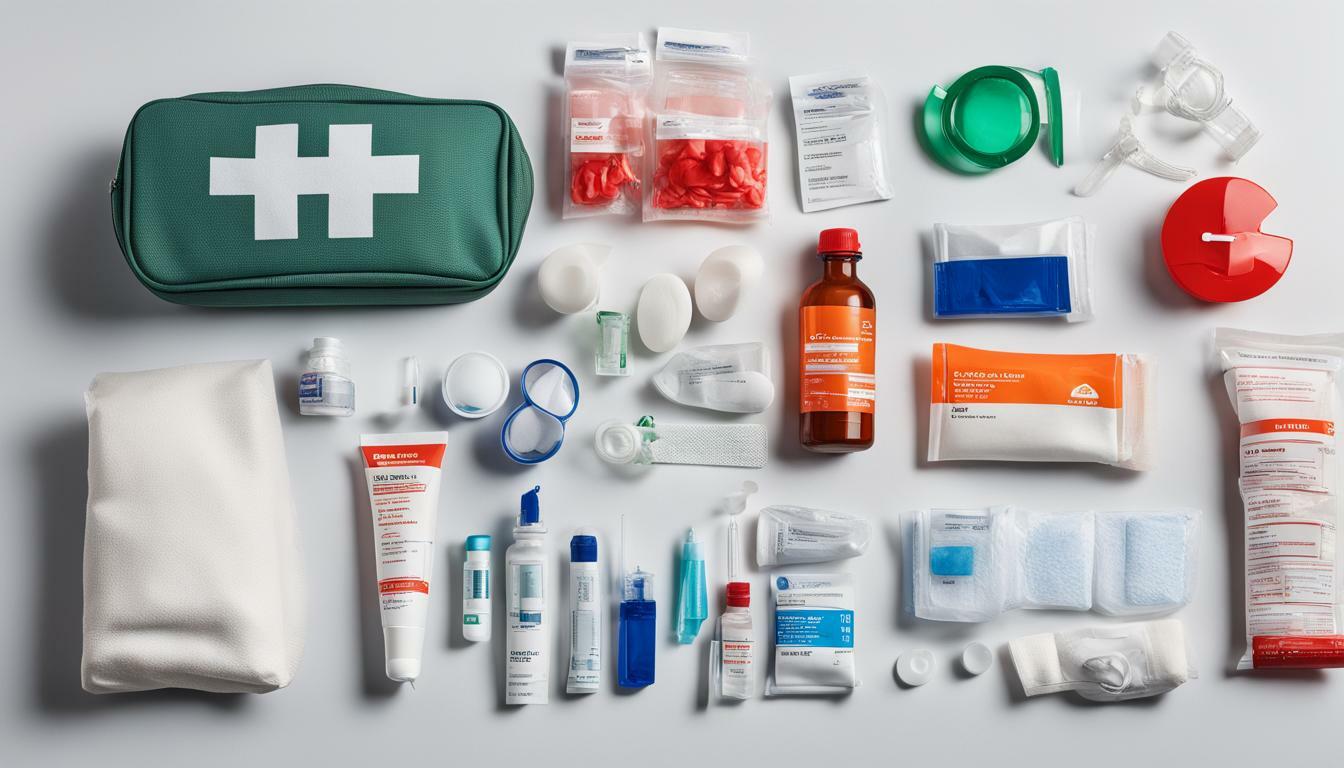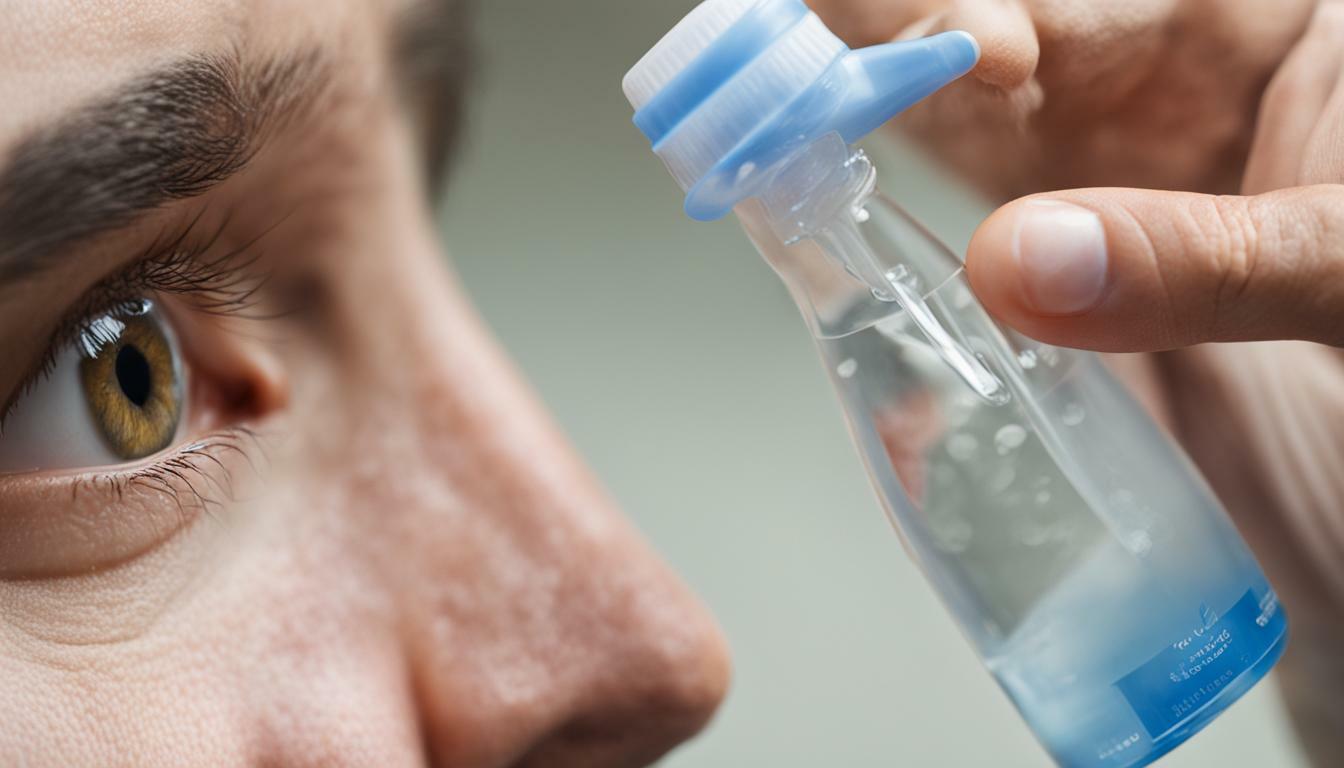Eye injuries can happen to anyone, at any time. Accidents, sports injuries, and even simple daily activities like cleaning can all pose a risk to your eyes. That’s why it’s essential to be prepared with the right emergency supplies in your first aid kit. In this UK guide, we’ll provide you with a comprehensive understanding of emergency eye care and outline the essential items your first aid kit should contain.
It’s crucial to understand how to properly care for an eye injury to avoid potential complications. In this guide, we will cover the necessary steps to take in case of an eye emergency, including assessing the severity of the injury, administering appropriate first aid measures, and seeking professional medical help when needed.
Key Takeaways:
- Eye injuries can happen at any time and to anyone.
- Being prepared with the right emergency supplies is essential.
- Proper first aid measures can help avoid potential complications.
Understanding Eye Injuries and Their Severity
Eye injuries can range from minor scratches to severe trauma that can result in permanent vision loss. It’s crucial to understand the different types of eye injuries and their severity to determine the appropriate first aid measures to take and the necessary supplies to include in your kit.
Common types of eye injuries include:
- Scratches or cuts to the eye
- Foreign objects in the eye
- Chemical splashes
- Blows to the eye
Assessing the severity of the injury is important to determine the level of care needed. Minor injuries such as scratches or small foreign objects may only require simple first aid, while severe injuries such as chemical splashes or blows to the eye require immediate medical attention.
When examining the injured eye, consider the following:
- Is the eye bleeding?
- Is there visible damage to the eye or surrounding area?
- Is the eye sensitive to light?
- Is there pain or swelling?
If the injury is severe or there is a risk of vision loss, seek immediate medical attention. It’s important to have a well-stocked first aid kit with the necessary supplies to manage any type of eye injury.

Essential First Aid Supplies for Eye Care
When it comes to eye emergencies, having the right supplies in your first aid kit can make all the difference in providing effective care and preventing further damage. Here are some essential supplies to include:
| Item | Purpose |
|---|---|
| Eye wash solution: | To flush out foreign objects, chemicals, or debris from the eye. |
| Sterile eye patches and adhesive tape: | To cover and protect the injured eye from further harm. |
| Sterile saline solution: | To rinse out contact lenses or to use as a substitute for eye wash solution if that is not available. |
| Artificial tears: | To alleviate dry or irritated eyes, or to help remove small particles that are stuck in the eye. |
| Eye dropper: | To administer eye drops or medication as prescribed by a doctor. |
| Flashlight: | To examine the eye in low-light situations or to locate foreign objects that may be difficult to see. |
Make sure to regularly check your first aid kit and replace any expired or used supplies. Additionally, it’s essential to familiarize yourself with how to properly use these supplies to avoid any further harm to the eye.

It’s also a good idea to keep a list of emergency numbers, including your eye doctor’s number and the nearest hospital’s emergency department, in your kit or in a nearby location.
Remember, these are just some of the essential items to include in your first aid kit for eye emergencies. If you have any specific eye care needs or chronic eye conditions, make sure to consult with your eye care professional to determine additional supplies that may be necessary.
Eye Safety Precautions and Prevention
Preventing eye injuries should always be a top priority. By following simple eye safety precautions, you can help minimize the risk of accidents and injuries. Here are some essential eye care tips to keep in mind:
- Always wear appropriate eye protection when working with tools, machinery, or other hazardous materials.
- Make sure your work environment is well-lit to reduce eye strain and fatigue.
- Take regular breaks when working on a computer or performing other visually demanding tasks.
- Wash your hands frequently to prevent the spread of germs and reduce the risk of eye infections.
- Avoid rubbing your eyes, which can cause further irritation or injury.
- If you wear contact lenses, make sure to follow proper hygiene and care instructions to reduce the risk of infection or other complications.
Along with these eye safety precautions, there are also several eye care essentials that can help maintain good eye health. These include:
- Eating a balanced diet rich in vitamins and nutrients that promote eye health, such as omega-3 fatty acids, lutein, and zeaxanthin.
- Getting regular eye exams to detect and address any potential issues early on.
- Using appropriate eye drops or artificial tears to keep the eyes moist and lubricated.
- Avoiding smoking and limiting alcohol consumption, both of which can increase the risk of eye problems and damage.
By following these simple eye safety precautions and incorporating these essential eye care practices into your daily routine, you can help protect your eyes and reduce the risk of injuries or complications.

First Aid Steps for Common Eye Injuries
Eye injuries can happen at any time and it’s important to know how to provide basic first aid before seeking medical attention. Here are the steps to follow for some of the most common types of eye injuries:
Foreign Objects
If a foreign object, such as dirt or debris, enters the eye, do not rub or touch the eye. Instead, follow these steps:
- Flush the eye with clean water for at least 15 minutes. Use a clean cup or container to pour water into the eye.
- If the object does not come out, cover the eye with a sterile eye patch or a clean, folded cloth and seek medical attention.
Note: Do not try to remove the object with tweezers or any other tool as this may cause further damage.
Chemical Splashes
If a chemical, such as bleach or acid, gets into the eye, follow these steps:
- Flush the eye with water for at least 15 minutes. Use a clean cup or container to pour water into the eye and ensure that the water is directed towards the nose to prevent further contamination.
- Remove contact lenses if present, but do not try to remove any particles on the lens.
- Seek immediate medical attention.

Cuts or Punctures
If the eye is cut or punctured, follow these steps:
- Cover the eye with a sterile eye pad or a clean, folded cloth.
- Seek immediate medical attention.
Note: Do not attempt to remove any object that is stuck in the eye.
Blows to the Eye
If the eye is hit or struck, follow these steps:
- Apply a cold compress to the affected eye to reduce swelling.
- If there is bruising or swelling, seek medical attention.
- If there is loss of vision, double vision, or pain, seek immediate medical attention.
Always remember to keep your first aid kit up to date and handy. Add any additional supplies recommended by your eye care professional for your specific needs. Do not hesitate to seek medical attention if you are unsure about the severity of an eye injury or emergency.
Additional Supplies for Specialised Eye Care Needs
For individuals with specialised eye care needs, it is important to have additional supplies in your first aid kit to cater to these needs.
Contact Lens Wearers: If you wear contact lenses, ensure that you have a small bottle of contact lens solution and a contact lens case in your kit. You may also want to include an extra pair of lenses, in case one is lost or damaged.
Chronic Eye Conditions: If you have a chronic eye condition such as glaucoma or dry eye syndrome, consider including any prescribed medications or eye drops that you use regularly. You may also want to include lubricating eye drops for dry eyes.
Children: If you have young children, consider including paediatric eye drops or eye ointment suitable for their age, as well as a small toy or distraction to comfort them during treatment.
Allergies: If you have known allergies that affect your eyes, it may be helpful to include antihistamine eye drops or oral antihistamines in your kit.
Remember, if you have any specialised eye care needs, it’s important to discuss with your healthcare provider what additional supplies you should include in your first aid kit.

Seeking Professional Medical Help
While first aid measures can provide immediate relief, it is crucial to seek professional medical help for any eye injury or emergency. Some eye injuries may require specialized treatment or surgery that can only be performed by an eye care professional. It is important to seek medical attention as soon as possible to prevent further damage to the affected eye.
If you experience any of the following symptoms, seek emergency medical attention immediately:
- Severe pain
- Changes in vision, including blurriness or double vision
- Bleeding in or around the eye
- Foreign objects that cannot be removed
- Chemical splashes to the eye
If you are unsure whether your eye injury requires medical attention, contact your healthcare provider or an eye care professional for guidance. They can help determine the severity of the injury and advise on next steps.
Remember: prompt medical attention can make all the difference in protecting your sight.

Educating Others on Emergency Eye Care
One of the best ways to protect your own eyes and those around you is by educating others on emergency eye care. Whether it’s friends, family, or colleagues, spreading awareness about eye care essentials, prevention strategies, and first aid measures can make a difference when it comes to protecting our eyes from potential harm.
It’s important to start by emphasizing the importance of seeking medical help in the event of an eye emergency. While first aid measures can provide immediate relief, they are not a substitute for professional medical attention. Encourage everyone around you to seek out an eye care professional in their area and to have their eyes checked regularly, even if they don’t currently have any symptoms.
In addition to seeking medical help, educating others on basic eye care practices can also go a long way in maintaining healthy eyes. Encourage everyone to wear protective eyewear when engaging in activities that could potentially harm the eyes, such as sports or DIY projects. Stress the importance of not touching or rubbing the eyes excessively, as this can increase the risk of infection or injury.
Another important aspect of eye care is understanding the warning signs of potential eye problems. Educate others on the symptoms of common eye conditions, such as red, itchy, or dry eyes, and encourage them to seek professional help if they experience any of these symptoms.
Finally, make sure to share the essential items that should be included in any first aid kit for emergency eye care. This will not only help others be prepared for any potential eye injuries, but it will also ensure that they are equipped to provide effective first aid in the event of an emergency.

By spreading awareness about emergency eye care, we can help protect our own eyes and the eyes of those around us. Remember to encourage everyone to seek professional medical help in the event of an eye emergency, educate them on basic eye care practices, and share the essential items for a well-equipped first aid kit.
Conclusion
Injuries to the eye can be serious and have long-term consequences, which is why it’s important to be prepared for any emergency situation. By following our guide on emergency eye care, you can ensure that you have the necessary supplies and knowledge to manage any eye injuries effectively. Remember to always seek professional medical help for any eye injuries or emergencies, no matter how minor they may seem.
By taking preventative measures, such as wearing protective eyewear and practicing good eye care habits, you can minimize the risk of eye injuries. Educating others on the importance of emergency eye care and prevention strategies can also go a long way in protecting the sight of those around you.
Assemble your first aid kit with the essential supplies outlined in this guide and keep it in a safe and easily accessible place. Don’t forget to regularly check the expiration dates of the supplies to ensure they’re still effective when needed. By taking these steps, you can be better prepared to deal with any eye emergency that may arise.
